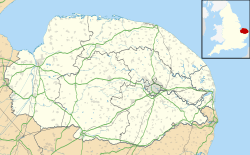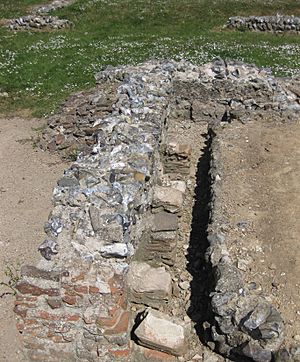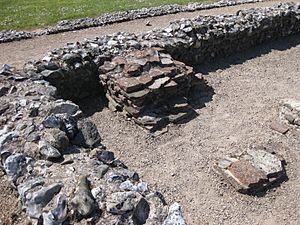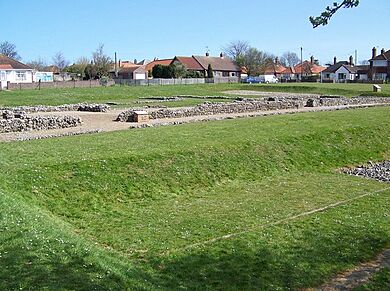Caister Roman Site facts for kids
Quick facts for kids Caister Roman Site |
|
|---|---|
| Norfolk, England | |
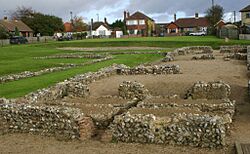
Caister Roman Site
|
|
| Coordinates | 52°39′00″N 1°43′09″E / 52.6500°N 1.7193°E |
| Grid reference | grid reference TG517122 |
| Type | Roman Shore Fort |
| Site information | |
| Owner | |
| Open to the public |
Yes |
| Condition | partially excavated remains |
| Site history | |
| Materials | Flint and some brick/tile |
Caister Roman Site is an ancient Roman fort located in Caister-on-Sea, Norfolk, England. It was part of the Saxon Shore forts. The Romans built it around 200 AD. It was used by units of the Roman army and navy. People lived here until about 370-390 AD. This fort might have been known as Gariannonum. However, another Roman site at Burgh Castle might also have had that name.
Contents
Discovering Caister Roman Fort
This Roman fort was originally about 3.5 hectares (8.6 acres) in size. It was roughly square-shaped. It had strong stone walls that were 4 to 5 meters (13 to 16 feet) high. There were also earth banks and ditches around it. These ditches were about 175 meters (574 feet) long on each side.
The fort had defensive towers at its corners. It also had strong gatehouses in the middle of each side. When it was built, the fort was on the north side of a river mouth. A paved street led from the fort's south gate to a nearby harbor.
Around 260 AD, another fort was built at Burgh Castle. This fort was on the opposite side of the river mouth. Both forts likely helped protect Roman ships in the area.
What Remains Today
Between 1951 and 1955, parts of the fort were dug up by archaeologists. The main structures were left open for people to see. These include part of the south gate and a section of the western wall. You can also see building foundations and a main road. Most of the fort, about 3.15 hectares (7.8 acres), is now under modern houses.
When you visit, you will see a large defensive ditch. This was the innermost of several ditches around the fort. You can also see part of the south gate. To the left of the gate are the remains of a small guard room.
Just north of the south wall are the remains of a long building. It was about 45 meters (148 feet) long. This building had at least six rooms of different sizes. Another part of the building extended northwards. On the south side, there was a parallel wall. This might have been part of a covered walkway. It also helped hold up the earth bank behind the fort's south wall.
One room in the building has a hypocaust. This was an ancient Roman system for heating floors. This building was likely used in the late 200s and 300s AD. It probably served different purposes, like homes or workshops. There is evidence that a fire badly damaged the building in the late 300s. In the courtyard area, you can see parts of older buildings. These include a corn-drying oven and a water tank.
When archaeologists first dug here, they thought this building was a hotel. Now, they believe it was part of the original fort.
After the Romans Left
After the Romans left, the site was empty for a while. Then, during the Middle and Late Anglo-Saxon periods (between 650 and 1066 AD), a new settlement was built near the center of the fort. A large Anglo-Saxon cemetery has also been found south of the fort.
Today, English Heritage looks after the remains of the fort. It is open to the public for free.
What Archaeologists Found
During the digs, archaeologists found many interesting things. These included four Roman coins from the mid-300s. They also found seven small collections of hidden items. Other finds included parts of walls made from wattle and daub (a mix of woven sticks and mud). They also found pottery, glass, part of a pewter plate, and grain.
Where is Caister Roman Site?
The site is on the western edge of Caister-on-Sea. This town is in the county of Norfolk. When the fort was built, it was on the north side of a large river mouth. This was where the Rivers Ant, Bure, Yare, and Waveney met the sea.
Today, the sandbank at Yarmouth has grown northwards. This means the fort is now quite far inland from the sea. The Roman Saxon Shore fort of Burgh Castle is a few miles to the southwest. Its ruins are much bigger than those at Caister. Burgh Castle is also in Norfolk now.
See also
 In Spanish: Fuerte romano de Caister para niños
In Spanish: Fuerte romano de Caister para niños


